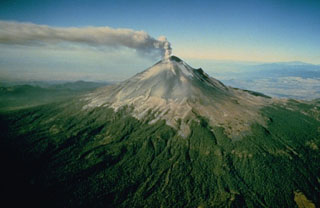Report on Popocatepetl (Mexico) — 3 February-9 February 2021
Smithsonian Institution / US Geological Survey
Weekly Volcanic Activity Report, 3 February-9 February 2021
Managing Editor: Sally Sennert.
Please cite this report as:
Global Volcanism Program, 2021. Report on Popocatepetl (Mexico) (Sennert, S, ed.). Weekly Volcanic Activity Report, 3 February-9 February 2021. Smithsonian Institution and US Geological Survey.
Popocatepetl
Mexico
19.023°N, 98.622°W; summit elev. 5393 m
All times are local (unless otherwise noted)
CENAPRED reported that each day during 3-9 January there were 14-34 steam, gas, and ash emissions from Popocatépetl. Minor crater incandescence from the crater was visible during a few of the nights. An explosion at 2138 on 6 February generated an eruption plume with low ash content that rose 2 km above the summit and drifted NE. The Alert Level remained at Yellow, Phase Two (middle level on a three-color scale).
Geological Summary. Volcán Popocatépetl, whose name is the Aztec word for smoking mountain, rises 70 km SE of Mexico City to form North America's 2nd-highest volcano. The glacier-clad stratovolcano contains a steep-walled, 400 x 600 m wide crater. The generally symmetrical volcano is modified by the sharp-peaked Ventorrillo on the NW, a remnant of an earlier volcano. At least three previous major cones were destroyed by gravitational failure during the Pleistocene, producing massive debris-avalanche deposits covering broad areas to the south. The modern volcano was constructed south of the late-Pleistocene to Holocene El Fraile cone. Three major Plinian eruptions, the most recent of which took place about 800 CE, have occurred since the mid-Holocene, accompanied by pyroclastic flows and voluminous lahars that swept basins below the volcano. Frequent historical eruptions, first recorded in Aztec codices, have occurred since Pre-Columbian time.
Source: Centro Nacional de Prevencion de Desastres (CENAPRED)

